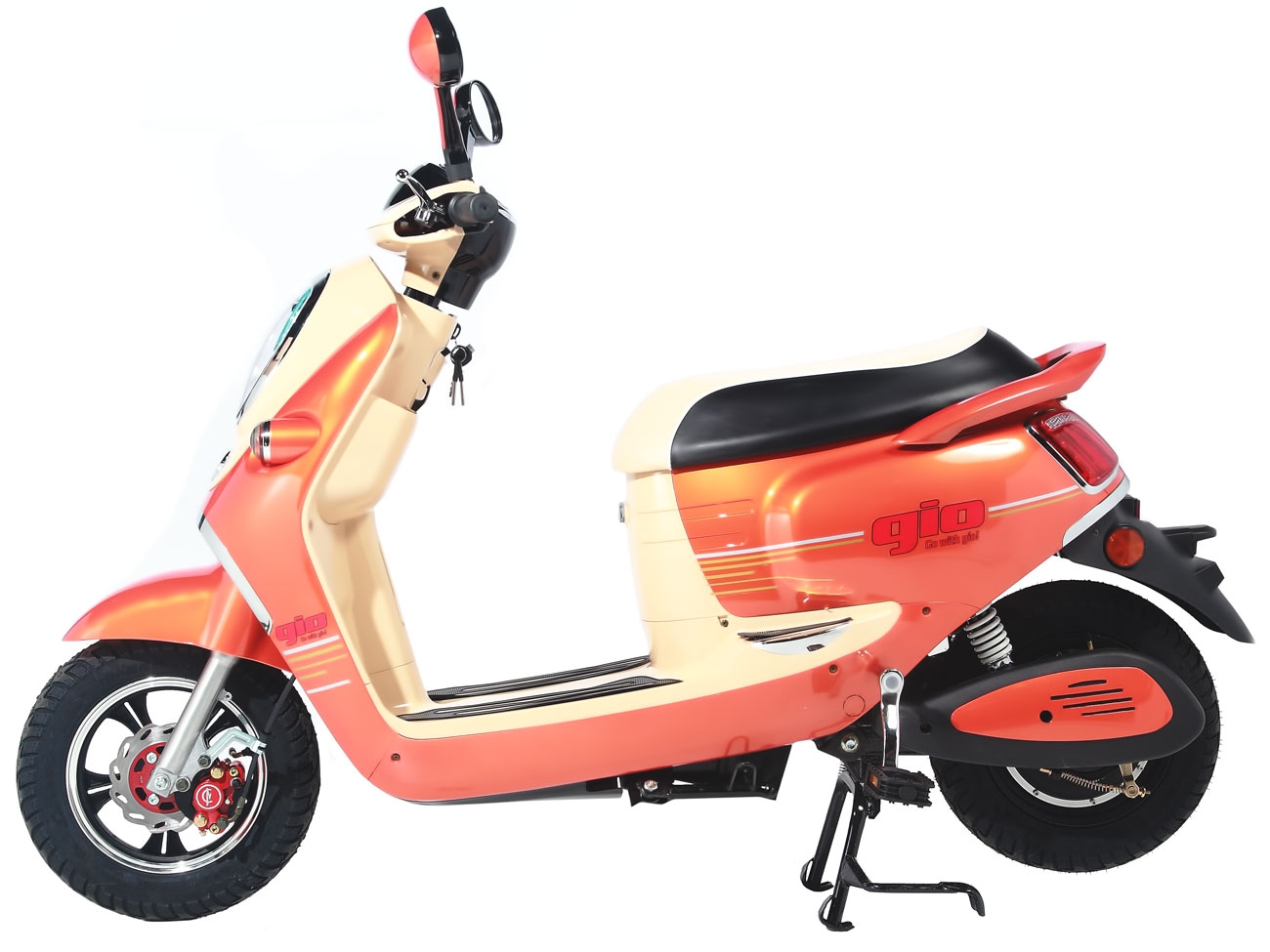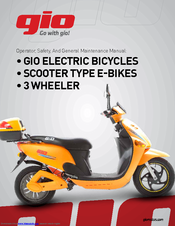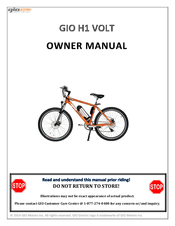Electric Scooter Troubleshooting Guide >Motor Does Not Run > Battery Pack Has Been Charged In The Last 3 Months

9.9.5 U-Lock: All scooters arrive with U shape lock as free accessory. The lock used for front wheel lock only. 10 General wiring schematic for GIO Electric scooters: Page 16 Italia 500w Electric Scooter Owner Manual.indd 16 2/5/2014 10:36:14 PM. Page 19: Troubleshooting. Key boost gio electric scooters - youtube secrets of droon search results for: ' gio pb 710 battery electric technical haynes scooters manuals: service and repair guides for 50cc 1949 farmall super c manual go-go elite traveller plus - specifications, study answer for chemical bond scooter-manuals - electric scooters, gas scooters, pocket 23.
When was the last time the battery pack was recharged?
Battery Pack Has Been Charged In The Last 3 Months |
Make Sure The Power Switch Is On
Determine that the key switch or power switch is in the on position.
Check The Fuse Or Circuit Breaker
If the scooters uses a fuse, look at the inside of the fuse to see if it is burned-out. The fuse may need to be removed from the scooter and held up to a source of light to determine if it is burned-out or not. For scooters that use a circuit breaker, push-on or flip the circuit breaker to see if it will reset.
Try Pushing The Scooter To Start
Electric scooters with single speed throttles sometimes need to be pushed forward in order to run. Stand on the scooter with one foot and push it forward with your other foot while fully engaging the throttle. Once the scooter reaches walking speed and the throttle is engaged the scooter should run until the throttle is released or the brake is used.
Try Charging The Battery Pack for 8 Hours
Electric scooters that have not been charged for over 3 months will have partially discharged battery packs which may not provide enough power to run the scooter. Try charging the battery pack for 8 hours and then see if that helps.
Inspect By Sight, Touch, And Smell
Remove the footplate or wiring cover and look for any burned or melted wires, wire connectors, or electrical components. Also look for loose, disconnected, or damaged wires or wire connectors. Pull and push on all of the individual wires and wire connectors to make sure they are not loose or disconnected. Get your nose close to the speed controller and motor and smell them. Any components that look burned or melted, or that smell like burned plastic are almost always defective and should be replaced. Motors that smell burned should be replaced to prevent damage to the speed controller.
Test The Fuse Or Circuit Breaker
(Tool Needed: Multimeter) Sometimes fuses burn-out in a place where you can't see it, and sometimes circuit breakers will mechanically reset but they are worn-out and still will not work. Checking the continuity of the fuse or circuit breaker with a multimeter is the best way to determine if they are working or not.
Test The Brake Lever Switch
(Tool Needed: Jumper Wire)The brake lever switch informs the speed controller to turn the motor off when the brakes are applied. Most scooters have normally open brake switches, however, some scooters have normally closed brake switches. To test for a faulty normally open brake switch, disconnect the brake lever wire connector from the speed controller and then see if the scooter runs. If the scooter run when the brake lever switch is disconnected from the speed controller then the brake lever switch is a normally open type which is faulty. To test for a faulty normally closed brake lever switch, disconnect the brake lever wire connector from the speed controller and bridge the two terminals together in the controller's connector that the brake switch is unplugged from. If the scooter runs when the controller's brake switch connector terminals are bridged together then the brake switch is a normally closed type which is faulty.
Test The Key Switch Or Power Switch
(No Tools Needed) Test the key switch or power switch for proper mechanical operation by moving it from the off position to the on position several times. The switch should snap into both positions. If the switch feels loose, or if it does not have a positive snap-action feel to it when switched between the on and off position then it may be defective.
(Tool Needed: Multimeter) Sometimes the key switch or power switch will feel good and have a positive snap-action feel to it when switched between the on and off positions but it will still be defective. Testing the continuity of the key switch or power switch with a multimeter is the best way to determine if it is working or not.
Test The Battery Charger
(No Tools Needed) Plug the battery charger into the wall and look for one or more illuminated indicator lights. If an indicator light is not illuminated or blinks on and off when the charger is plugged into the wall then the battery charger is defective.

(Tool Needed: Multimeter) If you have a multimeter you can test the battery chargers output Voltage. Its Voltage should be a few Volts above the battery chargers rated Voltage (24V, 36V, 48V, etc.). If the battery chargers output Voltage is zero, or if it is below the battery chargers rated Voltage then the battery charger is defective.
Test The Battery Charger Port
(No Tools Needed) If the battery charger is plugged into the wall, unplug it. Plug the battery charger into the battery charger port on the scooter and look for an illuminated indicator light on the battery charger. If an indicator light on the battery charger illuminates when the charger is plugged into the scooter then the wiring and wiring connectors going to the charger port are good and the charger port itself is good.
(Tool Needed: Multimeter) If you have a multimeter the battery charger ports Voltage can be tested. The Voltage level present at the charging port should be the same as at the battery pack.

Test The Battery Pack On A Scooter That Runs
Visit our Battery Pack Load Testing Guide.
Test The Battery Pack On A Scooter That Does Not Run
(Tool Needed: Load Tester) If the scooter is not running, a load test can be performed on its batteries by removing the battery pack from the scooter and taking the individual batteries out. The individual batteries can then be tested with a automotive battery load tester. Most entry level automotive battery load testers place a 100 Amp load on the battery which is too high so an adjustable carbon pile battery load tester is required and should be adjusted to place a 30 Amp load on the batteries.
Test The Voltage Of The Battery Pack
(Tool Needed: Multimeter) If you have a multimeter the battery packs Voltage can be tested to determine its condition.A good battery packs Voltage will be above its rated Voltage level even if it has been fully discharged and allows to sit a few minutes, or if it has been in storage. If a battery packs Voltage does not bounce back to above its rated Voltage level within a few minutes after being discharged that points towards a defective or worn-out battery pack. When a battery pack has been fully charged and its Voltage is below its rated Voltage level that also points towards a defective or worn-out battery pack. Good scooter battery packs will bounce back to above their rated Voltage level within a few minutes after the scooter has been driven.
Test The Throttle
(Tool Needed: Multimeter) Visit our Throttle Testing Guide page.
Gio Electric Scooters Manual
Inspect The Speed Controller

Look for any burned or melted wires or wire connectors on the speed controller. If any wires are burned or melted then the speed controller may be defective.
Smell the speed controller for any burned plastic smells. If the speed controller smells burned then it is almost always defective.
If the speed controller has no burned or melted wires and it does not smell burnt then it still could be defective. Test all of the other components of the electrical system around the speed controller and use the process of elimination to detect if the speed controller is working or not.
Speed controllers are too complex to easily test. Using inspection and the process of elimination is the best way to determine if a speed controller is working or not. If all of the other components of the electrical system test good but the scooter does not operate that indicates a defective speed controller.
Inspect The Motor
Look for any burned or melted wires or wire connectors attached to the motor. Burned or melted wires or wire connectors indicate overheating of the motor which may cause the plastic insulation to melt off the motors electromagnetic copper wire windings.
Gio 500w Electric Scooter Owners Manual
Smell the motor for any burned plastic smells. If the motor smells burned that indicates that its coils have been overheated. Motors with overheated coils should always be replaced to prevent damage to the speed controller.
If the insulation melts off the copper windings they will short circuit and cause the motor to not run or to run slowly. Short circuited motor windings can also burn-out the speed controller by giving it too much resistance which makes it work too hard and overheat.
Collection of mobility scooter wiring diagram. A wiring diagram is a streamlined standard pictorial representation of an electrical circuit. It reveals the elements of the circuit as streamlined forms, and also the power and signal connections in between the gadgets.
A wiring diagram usually provides information regarding the loved one placement as well as setup of tools as well as terminals on the devices, in order to help in building or servicing the device. This is unlike a schematic diagram, where the arrangement of the parts’ interconnections on the representation typically does not represent the parts’ physical places in the finished device. A photographic representation would certainly show more information of the physical appearance, whereas a wiring diagram utilizes an extra symbolic notation to highlight interconnections over physical appearance.
A wiring diagram is usually used to fix troubles as well as to make certain that all the links have been made and that whatever is existing.
mobility scooter wiring diagram
Wiring Diagram Pics Detail:
- Name: mobility scooter wiring diagram – Victory Trailer Wiring Diagram Best Pride Mobility Victory Scooter Wiring Diagram Wiring solutions
- File Type: JPG
- Source: eugrab.com
- Size: 405.48 KB
- Dimension: 1654 x 1169
Wiring Diagram Sheets Detail:

- Name: mobility scooter wiring diagram – pride mobility scooter wiring diagram Collection Pride Victory Scooter Wiring Diagram 4 d DOWNLOAD Wiring Diagram
- File Type: JPG
- Source: metroroomph.com
- Size: 517.41 KB
- Dimension: 1024 x 1375
Variety of mobility scooter wiring diagram. Click on the image to enlarge, and then save it to your computer by right clicking on the image.
A Beginner s Guide to Circuit Diagrams
A very first appearance at a circuit representation might be complex, yet if you can review a subway map, you could read schematics. The function is the same: getting from point A to direct B. Literally, a circuit is the path that enables electrical energy to flow.
The Language of Circuitry
Initially, allow s take a look at several of terms that you will require to know:
Voltage: Gauged in volts (V), voltage is the stress or force of electrical power. This is typically provided by a battery (such as a 9V battery) or mains electrical energy, the outlets in your home run at 120V. Electrical outlets in various other nations run at a different voltage, which is why you require a converter when traveling.
Current: Existing is the circulation of electrical power, or more particularly, the flow of electrons. It is determined in Amperes (Amps), as well as could just move when a voltage supply is linked.
Resistance: Measured in Ohms (R or O), resistance defines just how quickly electrons can flow with a material. Products such as gold or copper, are called conductors, as they conveniently enable circulation of movement (low resistance). Plastic, timber, and also air are instances of insulators, inhibiting the activity of electrons (high resistance).
DC (Straight Existing). DC is a continual circulation of present in one direction. DC can flow not just through conductors, yet semi-conductors, insulators, as well as also a vacuum.
A/C (Rotating Existing). In AC, the flow of current periodically alternates between 2 directions, frequently creating a sine wave. The frequency of Air Conditioner is determined in Hertz (Hz), as well as is usually 60 Hz for power in residential and also service objectives.
The Schematics
Finishing an electrical engineering degree as well as then getting a task in the area suggests you will certainly see a great deal a whole lot a lot of these schematics. It s crucial to understand exactly what is going on with these.
Beginning to make good sense? These are the essentials as well as might also appear obvious or intuitive to you, such as the cords and if they are linked. Whenever you determine your details field of electric design, you may see more intricate diagrams as well as symbols. You ll discover additionally that various nations make use of various icons. For example, of the two symbols for resistors above, the first one is utilized in the United States, while the second is utilized in Europe. You will certainly also discover the various icons made use of for buttons, other power products, inductors, meters, lights, LEDs, transistors, antennas, and a lot more.